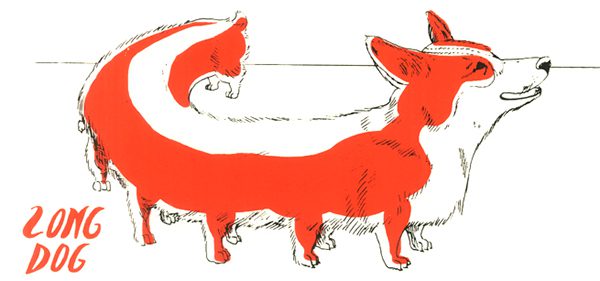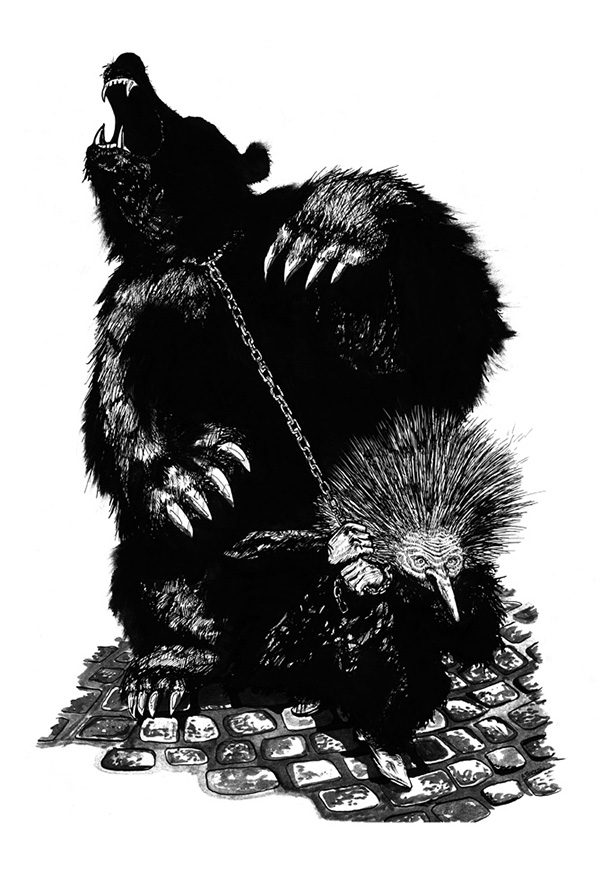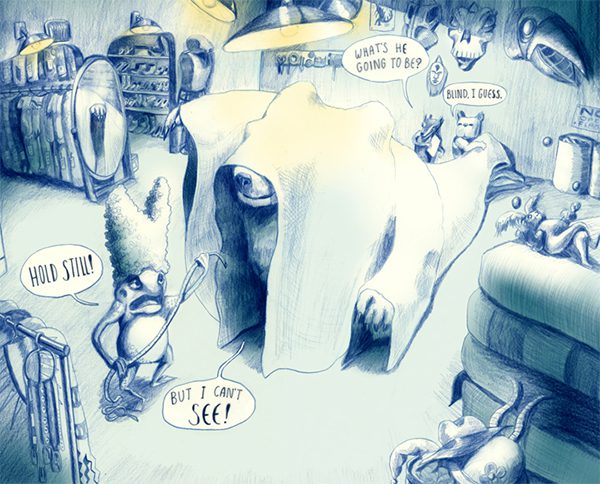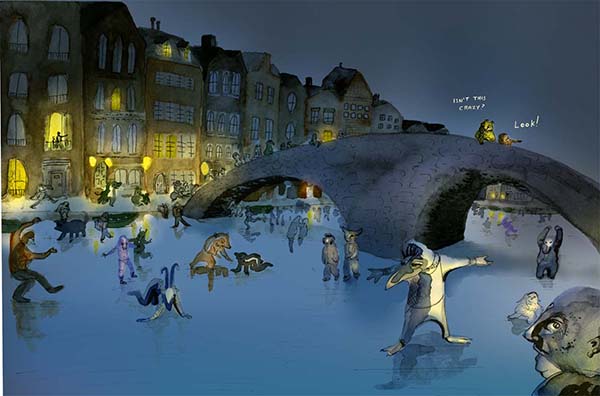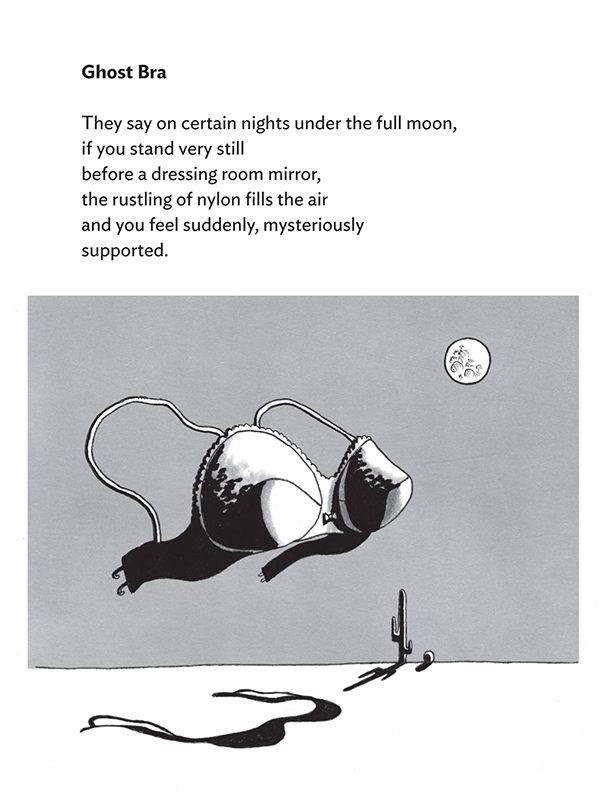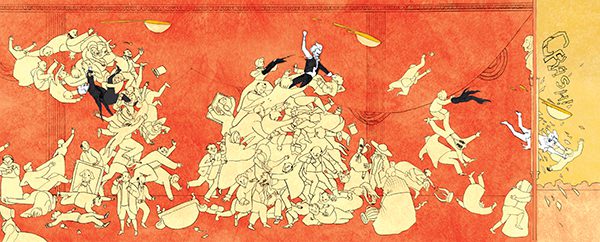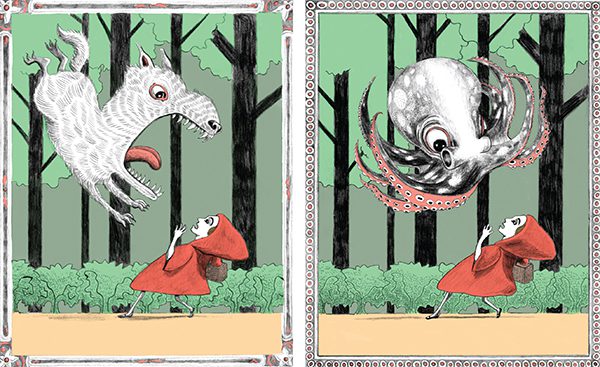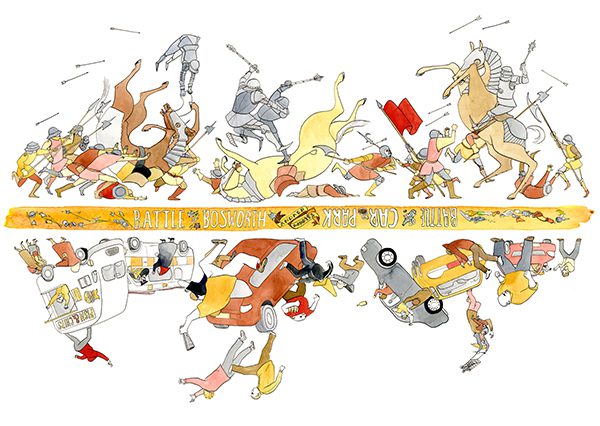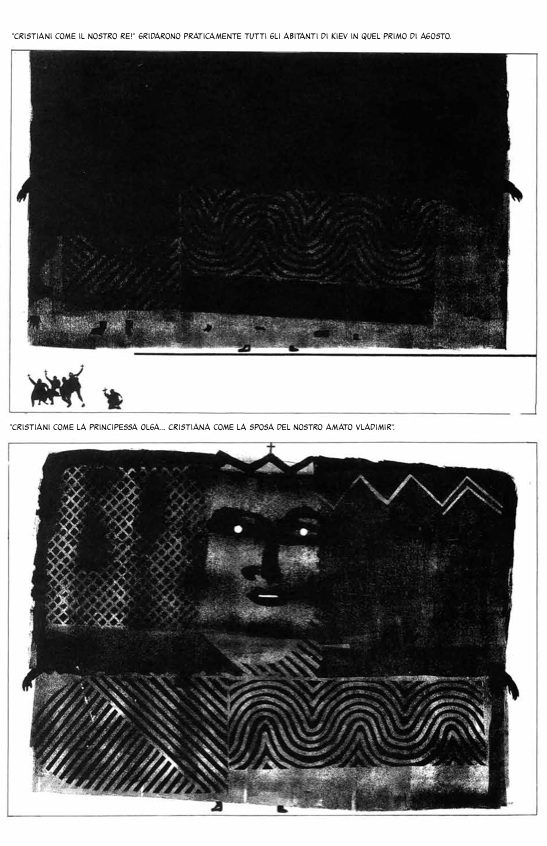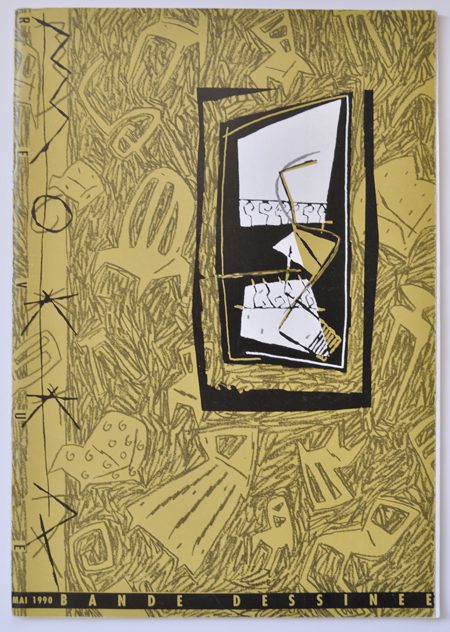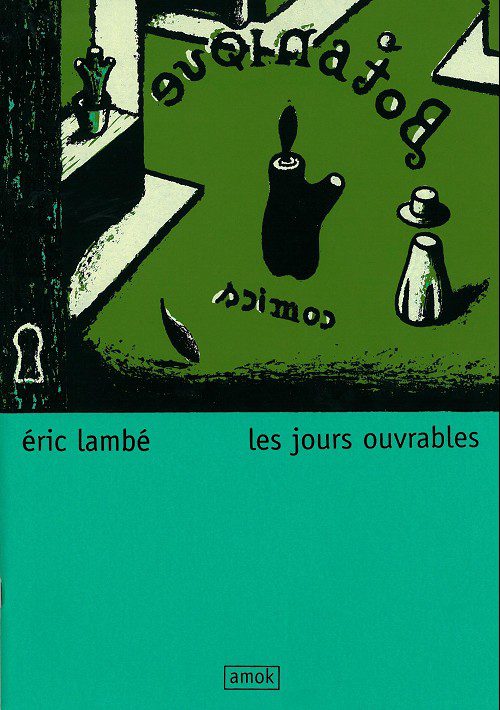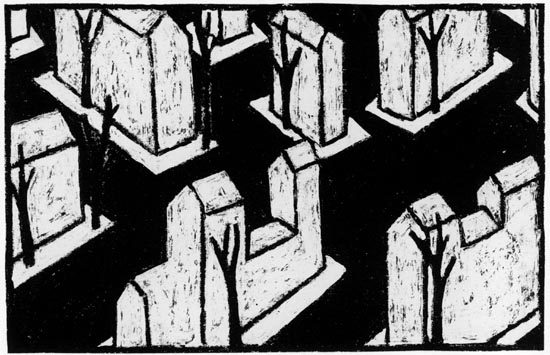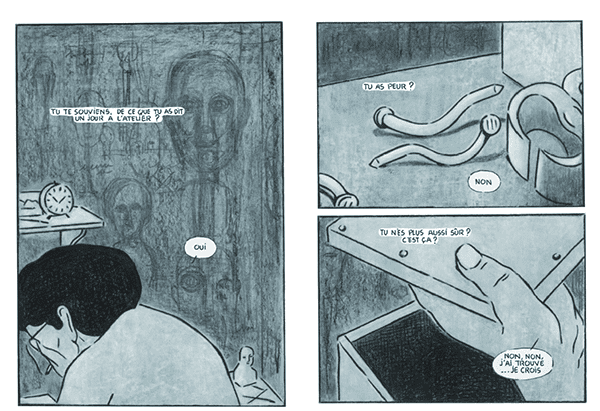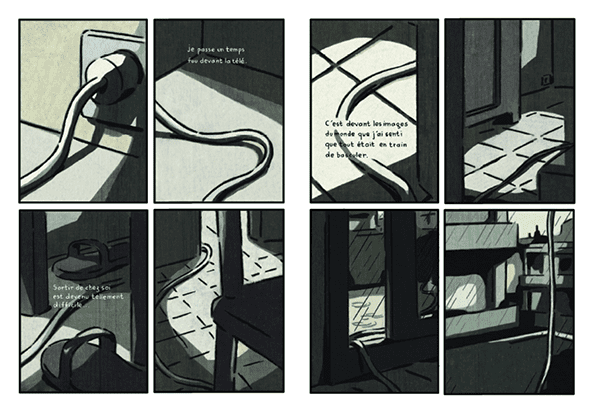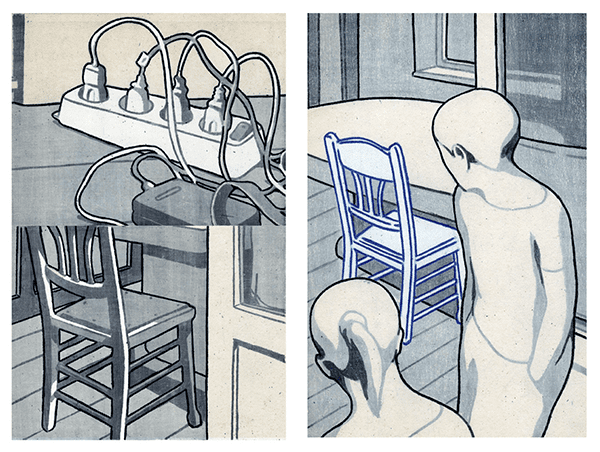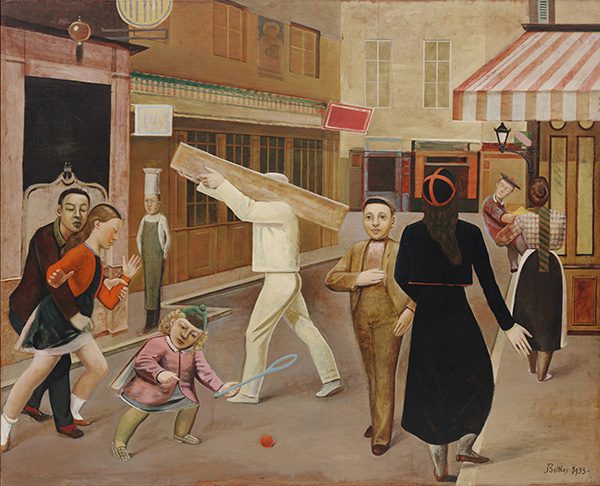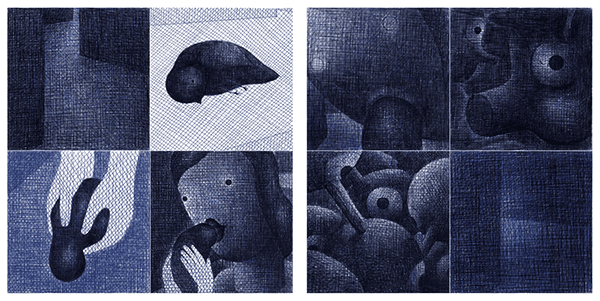The New York Comics & Picture-Story Symposium is a weekly forum for discussing the tradition and future of text/image work. Open to the public, it meets Monday nights 7-9pm EST in New York City. Presentations vary weekly and include everything from historical topics and technical demonstrations to creators presenting their work. Check out upcoming meetings here.
Andrea Tsurumi, a day shy of graduating from the MFA Illustration program at The School of Visual Arts, led the evening’s presentations with the projects she had been working on these past two intensive years. The first slide, of a silkscreen portrait of a multi-legged dog, summed up her storytelling aesthetic: short stories, long corgis. Which is to say, she is drawn towards the moments when reality mutates slightly, allowing monsters to come into play.
The portfolio she applied to the program with was much darker than her recent books have been. The monsters and witches have been a part of her drawings all along, but their role in her storytelling has changed remarkably. From traditionally structured horror comics and portraits of witches in black ink, she brightened up her line to better capture the more delicate nuances of monsterhood which intrigue her. These are the sorts of monsters who may pop their heads through the fabric of daily life. Just as her monster characters are native residents of her thoughts, so is her passion for telling stories. Tsurumi mentioned her teachers Tom Hart and Matt Madden as those responsible for giving her the confidence to pursue a career in which she would express them visually. Tsurumi’s formal background up until that point had been an English degree from Harvard University and a weekly art class she took growing up taught by a storytelling, Yiddish-cursing, and beloved teacher. The first assignments for kids, before moving on to more complicated tasks, involved drawing animals from calendars.
The idea for her first book in the program, Zoötrope, emerged from a short story by Brendan Matthews titled “My Last Attempt to Explain To You What Happened With the Lion Tamer” (notice the recurring theme: short stories, long titles). Riffing on the circus theme as well as her own experiences in theater set design, Tsurumi created a smokey, dichromatic world in which a traveling trope of circus animals performs almost exclusively to an audience of Russian sailors. She turned the spotlight a full 180 degrees from the center-stage. Rather, the book focuses on the minor and more awkward moments of the backstage mayhem: dressing the giant polar bear, leaving a small love note for a fellow performer, the line to the bathroom, the countdown to curtain-up, the fire extinguishers peeking out from every nook and cranny. She blurs the roles of the image and text by using the dialogue in the text balloons as illuminations of specific moments and the illustrations to build the narrative atmosphere.
In her following project, Over Here, she explores this idea in more depth with her first experimentations with color. The resulting adventure kicked off with a water-color course she took with Ruth Marten and The Wrong Place, a graphic novel by Belgium-based cartoonist Brecht Evens. The narrative was inspired by the true yet surreal experiences of life in NYC, particularly the huge blackout which paralyzed the entire Tristate-Area for about twelve hours in mid August of 2003. The entire population of the city flooded the streets, striking a random pattern of microconversations, gatherings, and parties. The city became a brand new puzzle to be sorted out for the sake of one’s survival and/or pleasure.
This project gave Tsurumi a chance to further distill her newfound aesthetic. The canals combing a large city suddenly freeze overnight, and the monster-citizens wander outside to take part in the event. Once she set this scene, she was free to become an observer of her own narrative. Tsurumi explained she takes on the role of the monster, the outsider, who is always made up of little bits of everything and as such is indescribable. Her mashed-up creatures are most alive in the shortest of moments, like an electrical pulse one might get a glimpse of through an occasional tear in reality.
Tsurumi titled her presentation “The Long Road to Lightening Up.” In the most recent series of small books she authored as part of her thesis project, her sense of humor takes center stage.
In regards to her particular sense of humor and the stories she chooses to exercise it with, she explained the importance of creating within a community of artists, and more specifically amongst her fellow students of the MFA Illustration program. Tsurumi said that the more familiar she became with how her peers edit their stories from week to week, and what makes them laugh, the more she understood the inner workings of her own sense of humor and could better choose the stories and backdrops which reflect it best. Humor is as important as any aspect of storytelling, because it is essentially an expression of a point of view rather than the cause of laughter. In fact, humor is often found in the most serious moments. It emerges through conflict and contradiction and the random juxtaposition of events. All these are the components of a good story.
Tsurumi’s thesis books all explore structures of narratives, but the narrative is carefully designed to point at the humor. There are no monsters in these books, in the sense that Tsurumi herself has quit the position of monster-hood, (i.e., the one-of-a-kind snapshot of a mutation in reality) for the position of director. There are still a fair share of robots, kill-bots, fashionable-bots, hunchback chefs and ghost brassieres, but their characters and movements were designed to a more specific end.
Andrew Jackson Throws A Punch is Tsurumi’s imagined story of the president’s infamous inauguration party. Her fascination with historical trivia and the myths surrounding the paradox of his beloved yet despicable personality, as well as her compulsive attraction to epic brawl scenes added up to a gatefolded comic book in which the seventh president barely tolerates having the entire public in the White House before snapping and throwing a bowl of punch onto the lawn in order to lure the menacing crowd outside. He loses his clothes in the process.
The second volume, But Suddenly, An Octopus!, sprouted from a digital-book class in which the students were instructed to design an interactive reading experience application. Tsurumi developed the basic notion that reading is always an interactive experience, be it digital or not. She authored a two-layered children’s book based on the ritual of a parent reading a bedtime story out loud to his child. The story that is being read throughout the book is Little Red Riding Hood. However, Tsurumi takes her reader through the many bedrooms of the many children who participate in the bedtime story ritual. Each child in turn suggests an “adjustment” to the classic story to suit their own desire. Tsurumi observes that these children never bear in mind the consequences of their actions. The accumulating demands on their parents to change the story send Little Red’s life spiraling downhill, to outer space and underwater. Their selfish tantrum ends with the altruistic realization of one little girl that the children must all unite to help restore the story as it was and get Little Red home safely into bed, just as they are themselves: she deserves a bedtime, too.
Behold the Killbot and Other Stories is a collection of sci-fi mini comics. Tsurumi explained that a large part of her process involves jotting down scraps of text from overheard conversations, stories from the news and media, and observed moments from both her daily life and her sci-fi-themed fantasy life. Some of these fragments require her to visualize them immediately, while some would require a more extensive execution plan.
Her epic depiction of the Battle of Bosworth and the flip-side Battle of the Parking Lot relating to the excavation of Richard III’s remains was one of these quick responses. Another type of sketchbook-to-paper stories is Boot-Bot, a shopping-obsessed robot who crosses the boundaries of morality and finds his tragic demise. It was based on her misreading of a text message. The simple roll-off-the-tongue sound effect literally rolled into being.
The kill-bot stories represent the essence of Tsurumi’s sensibility for storytelling. They are all narrated by Werner Herzog, thus anchoring the voice of the narration in a familiar reality. The depressed doomsday robots are some of the more prominent residents of Tsurumi’s own imagination, but they are expressed on paper through a filter of gesture, expression, and lighting as if she had observed in the real world. The merger of the real and the imagined elements; narration and image is a direct glimpse into Tsurumi’s description of being conscious of a moment that has been framed by humor. That is to say, it’s not a funny moment necessarily, but one that has been isolated and modeled to the point of its inevitable extraction from reality.
The second presenter of the evening, Eric Lambé, is a Belgian cartoonist who is currently touring the United States as part of “From Bande Dessinée to Artist’s Book: Testing the Limits of Franco-Belgian Comics” at the Center for Book Arts. Bill Kartalopoulos started the presentation by asking Lambé about the main influences on his work. Both France and Belgium have nurtured exemplary comic-book traditions and paradigms including the clear line style and the great adventure narrative. However, there have been surprising formal evolutions as artists venture into more poetic territories and create books that draw inspiration from artistic mediums outside the history of comics.
Like Tsurumi, Lambé takes note of the moments in life and the symbolic auras which isolate the details of the everyday world. He treats the book as a microcosmos and defines the artist’s role as a traveler, meditating upon that world.
Le fils du rois (The King’s Son) is the book on display in the Center for Book Arts. It is a thirteen-square-inch album compiled of drawings made with black and blue ballpoint pens over the course of six years. Its reproduction involved a complex color-separation printing process in order to keep it as faithful as possible to the original art. The result is closer in definition to a mass-produced art object than a comic book.
Lambé enrolled in St-Luc in Brussels, where he now teaches, already set on becoming a traditional Bande Dessinee artist, just like a close friend at the time. As a student, he acquired all the traditional skills of a BD artist, but his artistic revelation came from the punk culture erupting around him. Lambé regretted that becoming a comics artist required having a specific style that readers come to expect. What initially intrigued him about the punk zines was the liberty they allowed. There were no constraints to form, drawing techniques, style, content, or media. The pages were packed full of collages, cut-outs, photographs, xeroxes, washes, paintings sketches, and stamps.
1980s artists like Raul, Mark Beyer, Lorenzo Mattotti, and Alberto Breccia, as well as publications such as Raw Magazine and Bazooka, imprinted him with the passion for experimental or even abstract storytelling. He became interested in how a story can dictate a particular style and not vice versa.
In 1990, despite the fact that comics publications had been in financial distress for some time, Lambé collaborated with his fellow student Alain Corbel and others to put out an anthology titled Mokka. The co-editors showcased a collective of artists as an alternative to L’Association’s more traditional approach. They curated the art for their magazine not only from the Cartooning Departments, but also from the Illustration, Design, and Fine Arts Departments. Although the spirit of the magazine was entirely punk, it was important for the editors to design a cover that would resemble a fine-arts magazine more than a cheap fanzine.
Between 1991 and 1993, the original Mokka group had already dissolved, but Lambé and Corbel moved on to put out four issues of an international anthology titled Pelure Amere while corresponding with each other from the northern and southern corners of Europe.
Lambé’s first solo book, Les jours ouvrables, was published in 1997 by Amok. It collected short stories that had been previously published in various magazines over the course of eight years. Lambé said that during this time, he still felt he had to perfect his own significant manner of observing the world for the sake of his comics career.
It was only during the intensive work on his second book, Ophelie et les directeurs de ressources humaines, that he allowed himself to be taken on an unexpected journey. In complete contrast to the previous book, which assembled work spanning eight years, this one was completed in two months. Lambé was invited to a workshop with other artists by writer Olivier Deprez, and the latter suggested Lambé interpret the love letters of the Portuguese poet Fernando Pessoa. Lambé set off on a journey of discovery across Brussels via the piles of pages covering the floors of his studio. Lambé expressed the imagery without planning any form of scene breakdown. He moved from one shape to another, using white-out and ink, constructing compositions on multiple pages simultaneously as if he were walking in circles in a physical space.
Alberto G, a book about the life of the sculptor Alberto Giacometti, was the first project Lambé created while working with an author. The writer, Phillippe de Pierpont, approached Lambé mainly because of the insecurities Lambé had confessed to. Like Giacometti, Lambé questioned the relevance of having a personal style while struggling with the pursuit of one. There were also similarities between Lambé’s process of continuously searching for an abstract narrative with sculpting and spatial thinking. It took Lambé over a year to come up with a stylistic plan of approach to the delicate subject matter. When, one day, he accidentally drowned his under-drawing by applying a thick layer of acrylic and was forced to “fish” for the sunken lines with black ink, he finally completed the first spread of the book. The clean monochromatic compositions he created stand in contrast to Giacometti’s frantic dynamic line on the one hand, but on the other hand, they echo the grey tones, layered consciousness, and the physicality of his raw materials.
Lambé and de Pierpont continued to collaborate. Their book La Pluie was picked up by a much larger comics publisher this time, though the process of work on this project did not conform to the classic BD assignment of scenarist and artist. Lambé was given the novel written by de Pierpont and after reading it a couple of times, he set it aside and imagined the world of the story solely from the memories he had absorbed as a reader. It was important for them to retain the individuality of the voices they brought together into this book. The result is cinematic in the sense that the text moves around the image both thematically (as voice-over) and visually (arranged into the spaces and cracks of the composition after the fact).
Lambé went a step further in Joue avec moi, published by FRMK, (the fusion of Freon and Amok). He explained his preference of working without a given text or structure of any sort because it allows him to pick up on more delicate moments, thoughts, and accidents. The work on Joue avec moi was mostly comprised of sketchbook studies of his home environment—images of temporary tattoos he found in the gum packets he buys for his son, and portraits of his wife and the cables winding by her feet. The organization of the frames into a book fleshes out the symbolic significance of the seemingly mundane. The cables transform into Ariadne’s twine.
Le fils du rois was created over the course of six years. Lambé’s constant quest to refresh his point of view led him one day to pick up a ballpoint pen. He began to collect studies of anything he found interesting, from paintings that fascinated him, to “his cable leitmotifs,” to exploring the lighting in the different corners of a room, to marking dark heavy figureless blue panels. Kartalopoulos pointed out some of those references to Lambé, who in turn elaborated on the thoughts behind their inclusion. For instance, what fascinates him about the 1933 painting The Street by Balthus is that the man carrying the beam is the only figure who’s face isn’t shown. Lambé cast “the beam carrier” as the builder of the room he was constructing in his ballpoint studies.
Kartalopoulos ended the conversation with a discussion about the value of the original pieces versus the finished book. He asked whether Lambé considers the book and the art separate products in the same way he separates his drawing process from the final organization of the frames into a narrative structure. Lambé noted that during his work on La Pluie, he kept his drawing style rough and “disposable” because he wanted the book to be more pliable for editing. However, while creating the drawings for Le fils du roi, he already considered their impact in size and color on a gallery wall. The order of the drawings within the book is only one suggestion of an essay, or rather, a poem. By hanging the drawings up on the wall, he can offer the viewer multiple points of entry into the story. They could be seen all at once, or flipped through one by one, backwards or forwards. Conventional comic books always have a finite mode of reading. Lambé is interested in challenging the direction the narrative imposes on the reader and the artist alike. His role as an artist is not to illustrate but to conserve the tension between the text and the image and by so keep all the options alive.
***
Image 1: Andrea Tsurumi, Long Dog, 2012
Image 2:Andrea Tsurumi, Witches Series, 2010
Image 3: Andrea Tsurumi, Zootrope, 2012
Image 4: Andrea Tsurumi, Over Here, 2012
Image 5: Andrea Tsurumi, Behold the Killbot and Other Stories, 2013
Image 5: Andrea Tsurumi, Andrew Jackson Throws a Punch, 2013
Image 6: Andrea Tsurumi, But Suddenly, 2013
Image 7: Andrea Tsurumi, The Battle of Bosworth, 2013
Image 8: Andrea Tsurumi, Behold the Killbot and Other Stories, 2013
Image 9: Raul
Image 10:Mark Beyer, Raw Magazine #6
Image 11: Mokka, 1990
Image 12: Eric Lambe, Les Jours ouvrables, éd Amok,1997
Image 13:Eric Lambe, Ophélie et les directeurs des ressources humaines, Frémok, 2001
Image 14:Eric Lambe, Alberto G, written by Philippe de Pierpont, Fremok, 2003
Image 15:Eric Lambe, La Pluie, written by Philippe de Pierpont, Casterman, 2005
Image 16:Eric Lambe, Joue avec moi,Fremok, 2011
Image 17:Balthus, The Street, oil on canvas, 1933
Image 18: Eric Lambe, Le Fils du Rois, Fremok, 2013
***
About the author: Keren Katz is the illustrating half of The Katz Sisters duo. She is also the half that is not fictitious. They collaborated on the graphic novel The Night Poetry Class in Room 1001. You may view more of her projects here.

